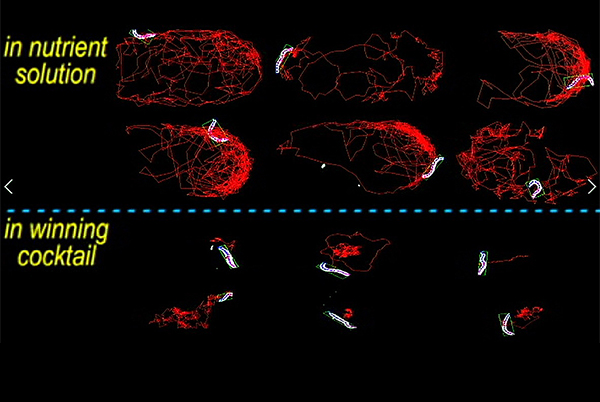Using a process that is poised to transform the artificial intelligence field, researchers from UCLA, Iowa State University and Shanghai Jiao Tong University have discovered an effective drug combination that could optimize the eradication of roundworms, common agricultural parasites that infect livestock. These and other parasites cost the agriculture industry billions of dollars yearly.
The research was published today, Oct. 4, in the journal Science Advances and highlighted by Iowa State’s News Service.
Roundworms, also called nematodes, infect livestock around the globe causing slow growth or even death. There are medicines, known as antihelmintics, which combat roundworms. However roundworms have been evolving drug resistance to these compounds, limiting their effectiveness. Multiple drugs that attack several resistance-causing molecular targets in roundworms are effective in alleviating the drug-resistance problem. However, there are a very large number of possible combinations drugs and doses. This presents a very time-consuming task to locate the optimized drug-dose combination.
With that in mind, the research team used a powerful technology platform, called feedback system control, or FSC, to search for the best combination of four common anti-roundworm drugs that would be most effective on the roundworm C. elegans, a common worm used in laboratory studies. Feedback system control was invented by Chih-Ming Ho, a distinguished research professor of mechanical and aerospace engineering at UCLA, and colleagues.
Different platforms based on the core technology have been used to find multi-drug combinations to fight tuberculosis; study pediatric cancers; and to clinically optimize liver transplant immunosuppression.
“Feedback system control is a game-changing technology for designing drug combinations, and this latest example shows it may drastically enhance production efficiency across the entire agriculture space,” said Ho, who was an author on the paper

Using cameras with custom tracking software, the experiments looked at how active the microscopic roundworms were when swimming in an enclosed chamber. Effective combinations of the four drugs at different doses showed roundworms that were much less active in swimming than in combinations that did not work. The feedback system control technique quickly eliminated those dead-end combinations, then provided new promising combinations to try.
“The FSC-driven AI rapidly and intelligently reconciles a massive set of data into a globally optimized solution,” said Ho, who is also a member of the UCLA Jonsson Comprehensive Cancer center. “Only a few searches can quickly find the optimal combination of drugs from a very large number of possible drug combinations.”
The researchers ran the process over just four rounds with only 32 combinations tested. The team found a very effective “cocktail” of four drugs that needed lower doses of each than if they were each used on their own. This process was much more efficient than testing approximately 10,000 of potential combinations to find the most promising ones. It takes dramatically much less time than traditional discovery of new drugs. .
This successful demonstration of an effective drug combination for nematodes could help find solutions to two major problems associated with nematode infections, said Santosh Pandey, a corresponding author on the paper and an associate professor of engineering at Iowa State University.
“One is multidrug resistance,” Pandey said. “These parasites are becoming more resistant to the drugs we have been using. Two is the tremendous expense of developing new drugs – it can take more than ten years and it’s very costly.”
Another advantage is that the technique does not require information on how the drugs work at biochemical level, or specific biological qualities of the animal host.
The researchers suggest that this could be used as a model to more quickly find effective drugs to combat other agricultural pests at low development costs.
The other corresponding author on the research was Xianting Ding, a professor at Shanghai Jiao Tong University and executive deputy director of its Institute for Personalized Medicine. Ding plans to expand the application scope beyond pest control, and is currently working with the Shanghai Institute for Agriculture Research to optimize crop productions, eradicate tree pests to avoid forest desertification and identify molecules in herbs that could be used in therapeutic drugs.
The other authors were Zach Njus, who was also a first author on the paper, and Taejoon Kong, both of Iowa State; and Wenqiong Su of Shanghai Jiao Tong University.
The research was funded by U.S. National Science Foundation and the U.S. Department of Defense’s Defense Threat Reduction Agency. Additional support came from the China’s State Key Laboratory of Robotics and the China Science and Technology Innovation Zone. Ho holds multiple patents on the technology platform.
Story by Matthew Chin
